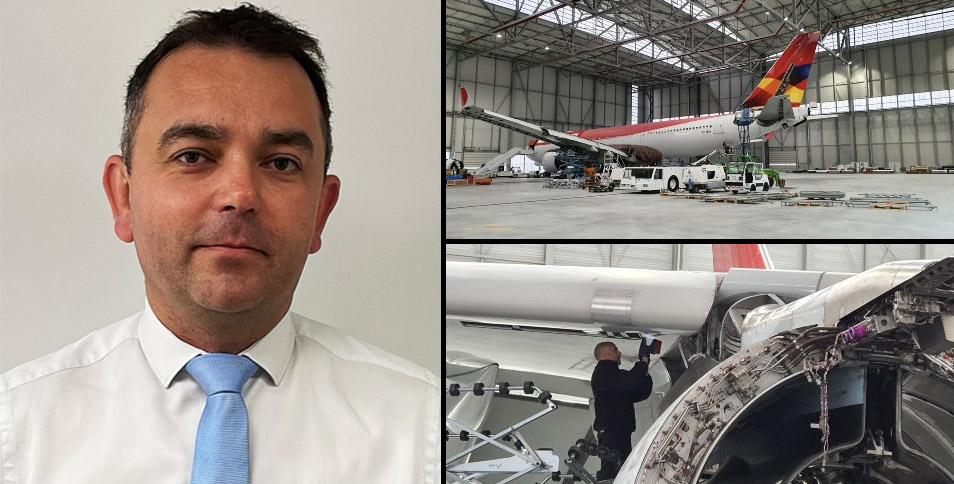
Vallair has been significantly growing its operations in Chateauroux, France this year, adding widebody heavy maintenance capabilities, a new maintenance hangar and a workforce training initiative at the site. Armel Jezequel, director of Vallair Industry at Chateauroux, talks with Lindsay Bjerregaard about how these efforts will drive its continued growth in the region.
Vallair opened a new Chateauroux maintenance hangar in February. How has this facility grown its capabilities?
Chateauroux has a rich aviation history dating back to 1936 when Marcel Dassault built his first aircraft factory. Prior to the opening of our maintenance facility, Chateauroux was the center of our aerostructure capabilities, and was focused on the repair and overhaul of nacelles, thrust reversers, flight controls as well as inlet and fan cowls. The team also specializes in a wide range of composite and sheet metal repairs on a variety of aircraft structures and components. Chateauroux is also the base for our inventory of rotable assets, which we repair and recertify in-house and supply to our customer base around the world. This includes an array of products, such as inlet cowls and thrust reversers for the CFM56-3, CFM56-5A and V2500-A5 engine types, as well as flight controls on Airbus A320 and Boeing 737 aircraft.
Adding maintenance to our capabilities has been a natural extension of our existing MRO capabilities in both Montpellier and Chateauroux, however, the new giant hangar has allowed us to expand into widebody heavy maintenance, which is a key focus for us moving forward. We will be focusing on A330 heavy maintenance with a view to expanding our capabilities to include A340s, A350s and possibly 777s in the near future.
Vallair also recently invested in a new training initiative with Aircraft Academy in France. How will this investment help Vallair meet its future workforce needs?
As aviation begins a ‘new normal,’ the demand for aeronautical technicians has never been higher. MROs are simultaneously facing augmented or deferred maintenance requirements combined with the natural retirement of their experienced work force. We have, of course, always partnered with training establishments within France, but this opportunity to proactively invest and support the aviation community within France is something we were keen to embrace. Upskilling our existing workforce and supporting their training requirements has always been a focus for us.
The Aircraft Academy is a fantastic opportunity for current aeronautical engineers looking to expand their skillsets, as well as those considering future careers in aviation. The training will benefit both Vallair employees as well as third parties looking to augment their skillsets, and will focus on Airbus A320/A330 family and Boeing 737 family aircraft. Trainees will also benefit from training across multiple engine platforms such as CFM, CF6, PW400, V2500 and the newer LEAP-1B.
What types of impacts has Vallair felt from the MRO workforce shortage and how else is it trying to alleviate this issue?
The pandemic impacted our teams significantly. As a direct result of the reduction in maintenance requirements, we saw that our aeronautical engineers were having to wait two or sometimes three years longer to attain the relevant licenses.
What do aftermarket companies in Europe need to be doing to help build the future workforce pipeline?
From a European perspective, it is important to build future workforces by selling the dream, or, as we say in French, le rêve, to the children and their parents from the school up. A career in aviation maintenance is a highly skilled job which can open many doors for you. The opportunities are there for the taking, and we need to encourage people to consider it as a serious life-long prospect.
The demand for cargo conversions still seems to be going strong. How much progress has Vallair seen in this segment, and are you ramping up growth to meet demand?
The pandemic resulted in a hitherto unseen rise in the demand for air cargo driven by the burgeoning demands of e-commerce, as well as the inability for people to travel themselves. Many airlines and operators utilized parked or stored aircraft to temporarily satisfy this demand, however, with passenger travel once more on the rise and the lifting/easing of travel restrictions, they are now looking for more permanent solutions to the air freight problem.
In 2020 we were excited to see our prototype A321F take to the skies, and we have been maintaining and managing our cargo conversion program carefully. We are proud to promote our future cargo conversion capabilities, which will be based in the new giant hangar, and we are looking forward to being able to efficiently relocate several of our conversion projects to France.



